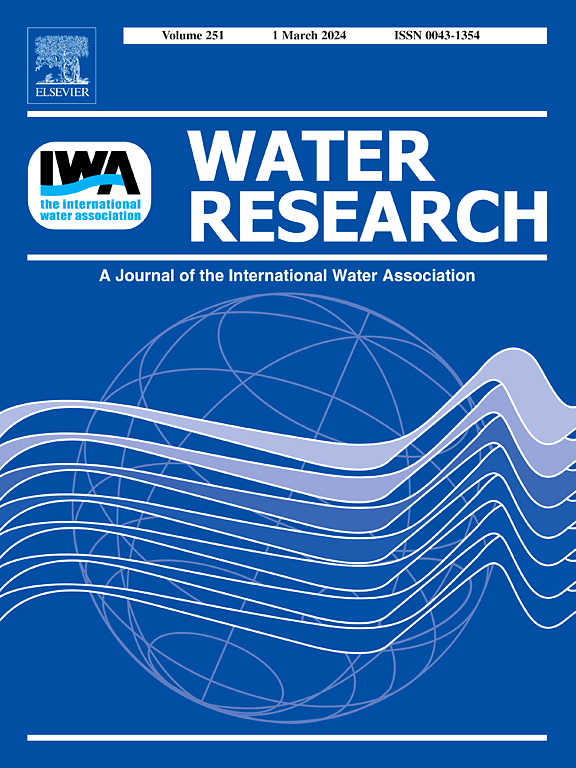Coupling microwave irradiation with peroxymonosulfate activation for sludge deep dewatering via enhancing internal bound water removal
IF 11.4
1区 环境科学与生态学
Q1 ENGINEERING, ENVIRONMENTAL
引用次数: 0
Abstract
Excess sludge deep dewatering remains a significant challenge for wastewater treatment sector due to the strong binding of internal bound water within sludge flocs. This study proposes a novel coupling system that synergizes microwave (MW) irradiation with peroxymonosulfate (PMS) activation to enhance the release and removal of internal bound water. By optimizing key parameters, including PMS dosage and MW irradiation time, the results demonstrated that the MW + PMS treatment reduced sludge moisture content from 85.9 % to 64.8 %. In comparison, sole MW or PMS treatments achieved water content reduction to only 84.1 % and 83.1 %, respectively. Electron paramagnetic resonance tests revealed the generation and accumulation of various reactive oxygen species, including ·OH, SO₄-· and ¹O₂, confirming the efficient activation of PMS. These oxidative species play a crucial role in breaking down extracellular polymeric substance network and microbial cell structure, thereby facilitating internal bound water release. Low-field nuclear magnetic resonance characterization further verified the effective conversion of tightly bound water to more mobile forms. Morphological and thermodynamic analysis indicated that the MW + PMS treatment induced a reduction in the sludge particle size and an increase in surface hydrophobicity. These changes resulted in the formation of cracks during filtration, enhancing water permeability and favoring its removal. More importantly, Lewis's acid-base interaction was identified as the leading force contributing to sludge flocculation and dewatering. This study may provide guidance for developing effective sludge deep dewatering technology.


微波辐照与过氧单硫酸盐活化耦合促进污泥深度脱水去除内部结合水
由于污泥絮凝体内部结合水的强结合,过量污泥深度脱水仍然是污水处理领域的一个重大挑战。本研究提出了一种新的耦合系统,微波(MW)照射与过氧单硫酸根(PMS)活化协同作用,以促进内部结合水的释放和去除。通过对PMS投加量和MW辐照时间等关键参数的优化,结果表明,MW + PMS处理可将污泥含水率从85.9%降低至64.8%。相比之下,单独的MW或PMS处理分别只减少了84.1%和83.1%的含水量。电子顺磁共振测试揭示了各种活性氧的产生和积累,包括·OH, SO₄⁻和¹O₂,证实了PMS的有效活化。这些氧化物种在破坏细胞外聚合物质网络和微生物细胞结构中起着至关重要的作用,从而促进内部结合水的释放。低场核磁共振表征进一步验证了紧密结合的水有效转化为更具流动性的形态。形态学和热力学分析表明,MW + PMS处理导致污泥粒径减小,表面疏水性增加。这些变化导致了过滤过程中裂缝的形成,提高了水的渗透性,有利于水的去除。更重要的是,Lewis的酸碱相互作用被确定为污泥絮凝脱水的主导力量。该研究可为开发有效的污泥深度脱水技术提供指导。
本文章由计算机程序翻译,如有差异,请以英文原文为准。
求助全文
约1分钟内获得全文
求助全文
来源期刊

Water Research
环境科学-工程:环境
CiteScore
20.80
自引率
9.40%
发文量
1307
审稿时长
38 days
期刊介绍:
Water Research, along with its open access companion journal Water Research X, serves as a platform for publishing original research papers covering various aspects of the science and technology related to the anthropogenic water cycle, water quality, and its management worldwide. The audience targeted by the journal comprises biologists, chemical engineers, chemists, civil engineers, environmental engineers, limnologists, and microbiologists. The scope of the journal include:
•Treatment processes for water and wastewaters (municipal, agricultural, industrial, and on-site treatment), including resource recovery and residuals management;
•Urban hydrology including sewer systems, stormwater management, and green infrastructure;
•Drinking water treatment and distribution;
•Potable and non-potable water reuse;
•Sanitation, public health, and risk assessment;
•Anaerobic digestion, solid and hazardous waste management, including source characterization and the effects and control of leachates and gaseous emissions;
•Contaminants (chemical, microbial, anthropogenic particles such as nanoparticles or microplastics) and related water quality sensing, monitoring, fate, and assessment;
•Anthropogenic impacts on inland, tidal, coastal and urban waters, focusing on surface and ground waters, and point and non-point sources of pollution;
•Environmental restoration, linked to surface water, groundwater and groundwater remediation;
•Analysis of the interfaces between sediments and water, and between water and atmosphere, focusing specifically on anthropogenic impacts;
•Mathematical modelling, systems analysis, machine learning, and beneficial use of big data related to the anthropogenic water cycle;
•Socio-economic, policy, and regulations studies.
 求助内容:
求助内容: 应助结果提醒方式:
应助结果提醒方式:


